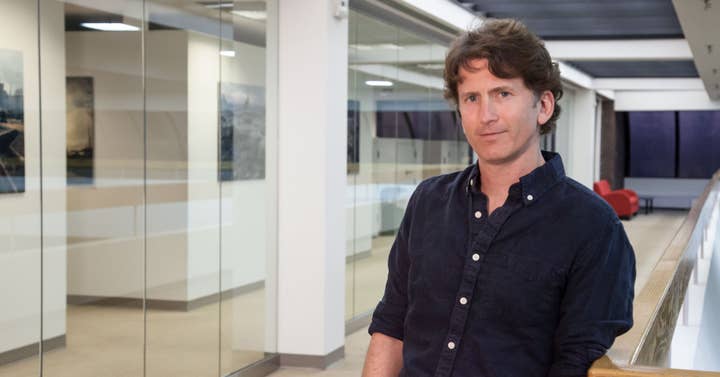Saved by Morrowind, striving for Starfield: Todd Howard and the story of Bethesda
The director of Elder Scrolls and Fallout discusses the past, present and future of both series in his Develop:Brighton keynote
The story of Todd Howard is largely the story of Bethesda -- if not the Softworks publishing side, then certainly the Game Studios development team behind the company's biggest games.
Today's keynote fireside chat as part of the Develop:Brighton online conference -- hosted by myself on behalf of GamesIndustry.biz -- explored Howard's career and the challenges of the games he has worked on.
We already spoke to him last week, where he told us the next generation is all about access, and now we present the highlights from today's keynote.
The Elder Scrolls
Howard's first experience with Bethesda's flagship series was assisting with the CD-ROM version of its first entry Arena, having already launched on floppy disks (remember those?). He then moved onto Daggerfall full-time, where the team refined the Elder Scrolls formula still used today. While Arena established the world of Tamriel, Daggerfall introduced the 'use skills to improve them' progression system.
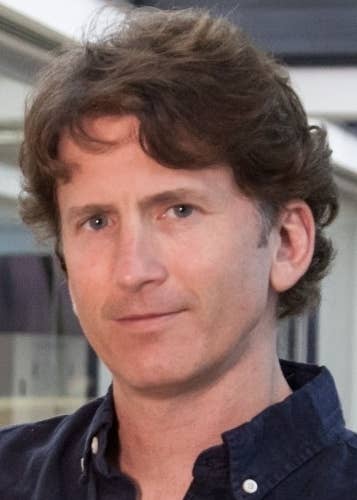
While neither title seems as accomplished as the likes of Morrowind or Skyrim by today's standards, Todd says they were ambitious for their time and started an ethos he and his team still follow today.
"Certain things can seem primitive through the lens of time and technology but we were doing similar things to what we're doing now, believe it or not," he says. "Even though the scale has increased, what we were doing in comparison to other games really hasn't."
He points to old reviews for Arena and Daggerfall, which would praise the sense of freedom and the breadth of the game world -- sentiments Bethesda continues to target with each new Elder Scrolls. But it was Morrowind that was "the beginning of the Bethesda people know today" -- and essentially saved the company.
"We'd made some bad games, we made some mistakes and the development team probably went down to six people," he says. "That's the game where we had no fear. We felt the company was going to go out of business, so when we had a chance to make Morrowind, we were like 'What's the worst that's going to happen?' We took a few more risks and if it hadn't worked out, I don't know that we'd be here. It worked out better than we could have imagined."
Crucially, Morrowind introduced Bethesda games to console owners via the Xbox version and demonstrated there was demand for those experiences on such platforms. Its success allowed the company to invest more into Oblivion, branching out with a PS3 version as well, and even helped it acquire the Fallout licence (more on that later).
Morrowind was a gamble for Bethesda, but Oblivion was a big bet in its own way. While most publishers would immediately leap onto a sequel, Howard says his team was given the luxury of a four-year development cycle in order to take advantage of the then-next-gen hardware. And while he disagrees there was more pressure on the sequel to Morrowind, he does admit the team took "more calculated risks with Oblivion."
"We felt the company was going to go out of business, so when we had a chance to make Morrowind, we were like 'What's the worst that's going to happen?'"
"We did not expect the success that one had either -- Oblivion just became this lightning rod for next-generation gaming at the time," he says.
It's the fifth Elder Scrolls, Skyrim, that stands as Howard's crowning achievement and the most successful Bethesda game to date. Celebrating its tenth anniversary next year, it drew in millions of players in a way none of the previous entries had managed. But why Skyrim?
"If I could answer that, it would be easy to do it time and time again," says Howard. "It was our third go around in that hardware cycle. We were really honing what we'd been doing. And the platforms had matured by then so the amount of people that had access to the game... Success is often based on access."
He also suggests it tapped into a wider trend. Game of Thrones' first series aired in the same year, so fantasy was very much part of the zeitgeist, and Skyrim could offer something that Westeros could not.
"The thing video games are best at is putting people in a world and saying, 'What would you do here?' and then having the world react to it," says Howard. "Skyrim does that, it has a flow and a vibe where whoever you are, if you like games at all, there's something for you. You give to the game and the game keeps giving back."
Part of the series' success since Morrowind has been the shift towards hand-crafted worlds rather than the procedurally generated landscapes of Arena and Daggerfall. Howard notes that the team has continued to use procedural generation, with Oblivion "somewhat procedural and then we went over it with hand to make sure things were the way we like them."
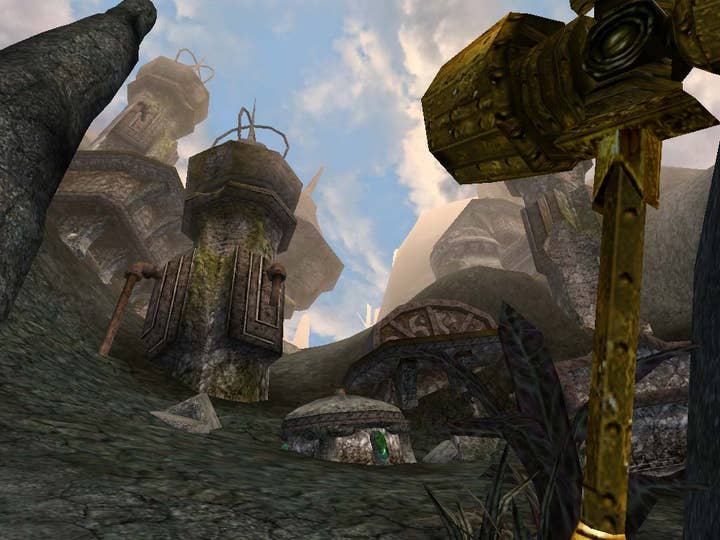
Some procedural generation is used to create content that ensures players never run out of things to do, such as Skyrim's ambient quests, but the most important things, such as the main story, are handled directly by the developers. Advances in computing power means more and more work can be handled procedurally, and it sounds like this will play a role in The Elder Scrolls 6.
"We like to experiment each game with procedural stuff, and then if it's not working out, go in and touch it," Howard explains. "The stuff we're doing now, we're pushing procedural generation further than we have in a very, very long time."
Fallout
After the success of Morrowind, Bethesda Game Studios wanted to branch out beyond Elder Scrolls. A number of ideas were passed around the team, but post-apocalyptic was top of the list. Howard was comfortable with the prospect of building 3D post-apocalyptic worlds -- he'd already done so on his first project, The Terminator: Future Shock -- but for him, it had to be Fallout.
"The thing video games are best at is putting people in a world and saying, 'What would you do here?' and then having the world react to it"
The IP had been dormant for some time, but Interplay still held the rights. Fortunately, some people at Bethesda knew who to contact, leading to one of Howard's favourite moments of his career, finding a sticky note left on his keyboard left by vice president of development Todd Vaughn. It simply read: "Fallout is yours."
To this day, Fallout 3 remains Howard's favourite project: "Obviously I love them all, but that holds a special place in my heart because it was so new for all of us and when you're making a Fallout game, there's so much you can do. There are very few ideas that you can't fit into a Fallout game in some manner. It mixes post-apocalyptic with drama, dark comedy, B-movies and, if you're doing it right, it moves between those in a way that it forges its own identity."
The crossover between Elder Scrolls and Fallout is clear to any who have played both series, but Howard says there are subtle but important differences in their development. For a start, Fallout games tend to "tell a more specific story" and the nature of player choices is purposefully made to be more difficult.
"Who do you side with? Who lives? Who dies? What are you going to sacrifice to live, given the nature of the world you're in?" says Howard of typical Fallout choices. "Elder Scrolls is a bit more systemic in its design. Intentionally, you can join all of the factions. There's not a specific choice."

The story also presents a difficult balance to strike. Elder Scrolls games are known for casting players as a blank canvas, an avatar with no backstory, leaving them free to dictate their motivations and ultimate destiny. The Dragonborn never has to defeat the dragons.
But Fallout 3 and 4 both give players a glimpse of their life before the adventure, with extended intros that leave them with a very clear objective: locating your missing father or kidnapped child, respectively. It creates a disconnect between the story the developers want to tell and the adventures players want to experience -- why would a mother searching for her child stop to help a robot gardener restore water to his greenhouse?
"The stuff we're doing now, we're pushing procedural generation further than we have in a very, very long time"
Howard admits that striking the balance is tricky: "And I don't know that we've solved it. You want some sort of time pressure on the player, but that fights against anything else you're doing. The stories we've told in Elder Scrolls suit that better."
He adds that Fallout 4's character is the closest the series has got to creating a role that most matches the player's experience: "You feel the loss of what's been destroyed because you were there. You feel the loss of your family. The game throws a lot of mechanics at you, and it takes a little while for you to feel comfortable in that world. It's a while before you see another human. Even though you know there's going to be more humans, if you're into it there's an hour or so where you wonder, 'Am I the only person alive?'"
Of course, Fallout 3's opening remains his favourite of any game he has worked on. While he recognises that growing up in Vault 101 may have been "overly long" in retrospect, without it, the feeling of stepping out into the Capital Wasteland would have been diminished.
"That got a lot of question marks internally when I was pitching it," he says. "But I thought it was important that when you step out, not just the visual but the emotion of it... it works for the reality of what you're playing."
Fallout 76, Howard's most recent project in that world, is perhaps the most ambitious. Originally conceived as a multiplayer mode for Fallout 4, the team learned that some quests didn't work in a multiplayer scenario. But inspired by survival games like Day Z and seeing the crossover with surviving a nuclear wasteland, they decided to make a prequel.
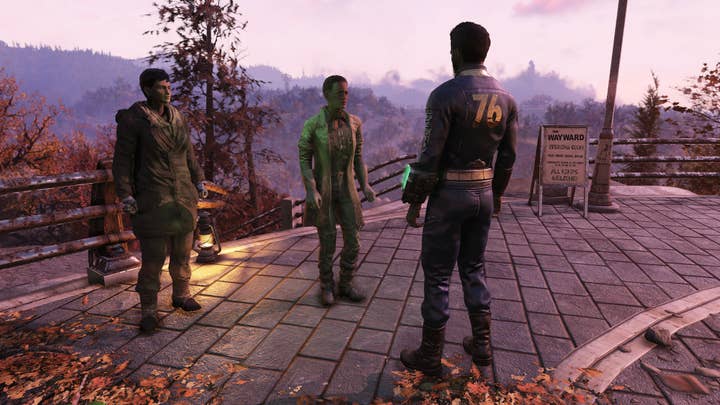
It started as a side project, but quickly grew momentum. One of the major challenges was trying to create an RPG with all the hallmarks of a Bethesda game -- but without NPC quest-givers. Fallout 76 players would be among the first to emerge from the vaults, tasked with building a new society. It's a hurdle Howard admits the team didn't quite leap, despite working hard to find solutions.
"The story stuff and the quests didn't go in until late in the project, and I think our designers did a great job with one-armed tied behind their back, trying to tell stories through holotapes, terminals and things like that," he says.
"We quickly recognised Fallout 76 wasn't giving our audience what they wanted. Without a doubt, we let a lot of people down"
"Whereas the survival aspects work for a lot of people, we quickly recognised that the game wasn't really giving our audience what they wanted and they were really let down by what we delivered on day one. Without a doubt, we let a lot of people down."
He adds: "We wanted to make something different, but the audience doesn't always want something different. And that's no fault of theirs, it's totally understandable. I think maybe we did a bad job of saying how different it was going to be."
Bethesda aimed to make a very systemic game, where players brought more to the table than they did with past Fallouts or the Elder Scrolls games. Since launch, the team has introduced more NPCs and expansions such as the recent Wastelanders have enabled players to enjoy it in much the same way as they would a classic Fallout game.
But there's no denying the launch was bumpy to say the least. Few live service titles have recovered from a rocky launch, but Fallout 76 has arguably established itself as one of them. Of course, Howard notes his team could take learnings from the struggles their colleagues at ZeniMax Online faced with the Elder Scrolls MMO. And, crucially, the players refused to let Fallout 76 die.
"Ultimately, despite the issues and the very well-deserved criticism we got, there were a lot of people playing," says Howard. "Not on the scale of a regular Fallout, but millions of people that told us there was something here, so let's keep at it. I'm hugely proud of the team who worked on the game and month after month made it better. I don't think there's a magic formula without having the discipline to go through the work. Without that community out there making this game their own and really believing in us, I don't know that we would have gotten to where we are."
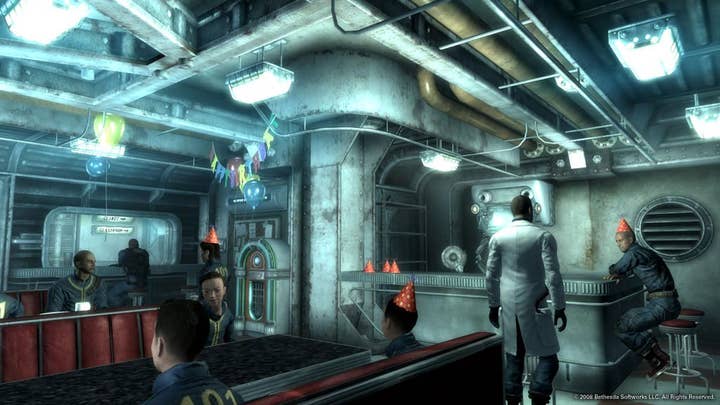
Howard is now focused on Starfield and Elder Scrolls 6, both single-player games, but doesn't rule out the prospect of another multiplayer-only Bethesda open world game. In future, he would do more extensive beta testing, rather than building something that most people experience first at launch.
"Overall, it's been a really positive experience for us," he says of Fallout 76. "It's made us much better developers, much more connected with our community. So I can't say it's going to be a one-off."
The Future
The arrival of the next-generation consoles and advances in PC hardware steer the conversation towards the future of both series. Fallout 76 runs on the same internally-developed engine as Skyrim, itself built on the codebase for Fallout 3. The tech running Bethesda's games has long since been highlighted by critics as needing a refresh, so could PS5 and Xbox Series X/S give it the boost required?
Howard says his team refreshes the engine with every game, but acknowledges that it "needs more work than it has in previous times." Which is why Bethesda has been investing heavily into improving it, with "more people doing engine work now by a factor of five than we've ever had."
"The overhaul on our engine is probably the largest we've ever had, maybe even larger than Morrowind to Oblivion"
"The overhaul on our engine is probably the largest we've ever had, maybe even larger than Morrowind to Oblivion," he says.
"There are things we do that we still like, the way we build our worlds, the way people can mod it -- these are things I think are fundamentally good about our tech stack. But from rendering to animation to pathing to procedural generation... I don't want to say everything, but it's a significant overhaul. It's taken us longer than we would have liked, but it's going to power everything we're doing with Starfield and Elder Scrolls 6. When people see the results, they'll hopefully be as happy as we are with what's on the screen and also how we can go about making our games."
Starfield and Elder Scrolls 6 were both announced at E3 2018, but little has been heard of them since and Howard is unable to suggest when we're likely to learn more about these projects. He reiterates that they were announced to assure fans Bethesda was still working on the experiences they'd expect, especially since the headlines that year were the multiplayer-only Fallout 76 and mobile spin-off The Elder Scrolls: Blades.
"We like to, as much as possible, really be able to show what the final product feels like and looks like when we're closer to release so that we're 100% confident in 'Here it is, here's what it does and here's when you can play it.'"

He adds that, while anticipation is already building for both Starfield and Elder Scrolls 6, he finds audiences can be "pretty forgiving" if you warn them how far out future games might be. Regular updates and previews during a long development cycling can potentially be damaging.
"It's a very different way of designing You can just be like, 'This will last for three years' or seven or ten. Maybe someone can do that, but I cannot. You have to think in terms of 'forever'"
"You just don't want to string them along too long. You get kind of fatigued," says Howard. "You have to balance that fatigue of wanting something versus that consumer excitement. Also it takes time, to be frank. Preparing trailers, demos and assets take time away from development. I remember games we've done where you're doing that for multiple years and it's like you have to top yourself. You have to top your previous demo. I'd rather spend all that time focusing on the game and prepare one big demo."
He points to the success of Fallout 4, which was announced six months before launch and certainly didn't suffer for it.
Besides, despite turning ten next year, Skyrim continues to be a widely played game. The Switch version was one of Bethesda's biggest releases of the past few years, proving the staying power that game has. Howard says the median time for players is 170 hours, driven in part by the modding community continuously finding new ways to refresh the game. While he says that Bethesda isn't exactly reliant on modders, they can be a boon for its games and "part of the vibe where, from the get go, a game feels endless." In fact, Bethesda is still working on new Skyrim content every month through the Creation Club.
Skyrim's success in particular has caused a shift in the design ethos behind its future games. While they're still aiming for that sense of freedom captured in the '90s by Arena and Daggerfall, knowing that people could still be playing after a decade requires more forward thinking than in the past.
"They're investing in this world, their time has real meaning to them and it does to us as well," says Howard. "So how can it go on forever? It's a very different way of designing when you use the word 'forever.' You can just be like, 'This will last for three years' or seven or ten. Maybe someone can do that, but I cannot. You have to think in terms of 'forever.'
"There are ways to do that that are easier than you think, but they water down the minute-to-minute and the hour-to-hour. You don't want those to feel like a grind -- we've all experienced games that do that."
You can watch the full keynote session below:
GamesIndustry.biz is a media partner of Develop:Brighton 2020
